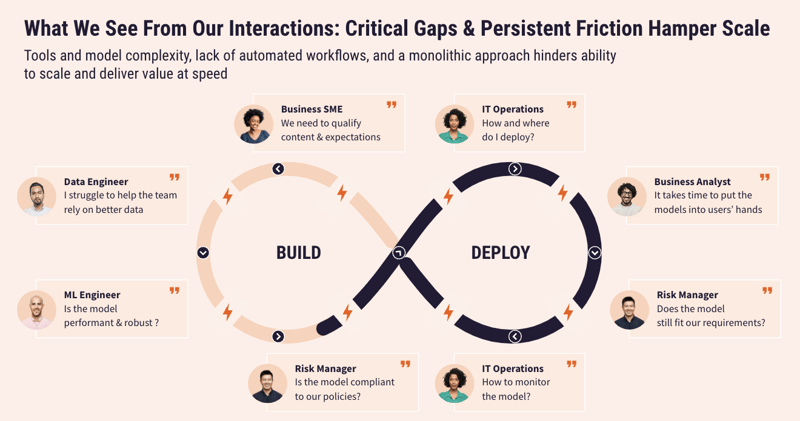Have you ever wondered why some AI projects fail to deliver their promised results? As highlighted by respondents in the 2023 Dataiku-sponsored IDC InfoBrief "Create More Business Value From Your Organizational Data,” a lack of effective technology, production-ready data pipelines, and an environment that facilitates smooth project transitions from experimentation to production are some of the key reasons. But the good news is that IT can play a critical role in overcoming these challenges.
In this blog post, we'll explore the challenges faced by organizations when implementing AI projects and how IT can help to create more business value from your organizational data. So, fasten your seatbelts and learn how IT can be the game-changer you need to set yourself up for AI project success!
Too much bad data? Power up your AI project with...
IT Superpower #1: Discover, Clean, & Leverage the Right Data to Fuel Projects
The quality of data is the mother of all battles in AI. It's a recurrent problem pointed out by every study due to the essential role that data plays and the complexity of solving it.
Data pipelines are the lifeblood of AI. You can have the best AI strategy, but without the right data, your projects won't succeed. So, what's the issue here? The accuracy, relevance, and completeness of data determine the quality of AI models. This is where IT stakeholders come in as the guardians of data integrity.
However, IT stakeholders aren't always in charge of data quality.
Their role is to orchestrate data quality during complex ingestion tasks and delegate data quality tasks to the ones who know the data best, the business departments, for correction in a decentralized approach without losing control.
For example, a marketing manager would know how to segment customers and attribute segmentation to the right customer typologies. This expertise lies with the marketing department, not the data engineer. However, the data engineer knows the tools and can delegate them in a self-service approach. The collaboration between these two is crucial in facilitating the involvement of business expert teams in data resolution. This duo is the cornerstone of success for data/AI projects.
Too slow to operate? Boost your AI project's efficiency with...
IT Superpower #2: Operationalize Your AI Projects on a Production-Grade AI Infrastructure
Despite progress in operationalizing AI projects for production, there is still a long way to go to guarantee efficient automation of AI/ML projects. We often hear about common challenges that slow down their progress.
Some of the most common questions include:
- How can we streamline team hand-offs and reduce the time and effort involved?
- Is there a way to avoid re-coding the entire project for production?
- How can we eliminate the manual and error-prone process of delivering projects into production?

IT teams play a crucial role in operationalizing projects, including deployment, production, and monitoring phases. They must ensure the timely delivery of projects and monitor their performance once in production. Project management is a critical dimension that IT stakeholders are responsible for.
According to our IDC study, 35% of respondents confirmed that technology is still a major obstacle to project success. One of the key elements in operationalization is also the ability of IT to ensure that the underlying environments for AI/ML projects are robust and production ready. Cloud infrastructure plays a significant role in providing flexibility and power, allowing for on-demand computing and adequate storage without incurring prohibitive costs.
IT stakeholders ensure that the hardware, software, and network infrastructure are scalable and compatible with the project's requirements. Without their involvement, AI projects may fail due to insufficient processing power, inadequate storage forcing projects, or too many air gaps in the operationalization workflow.
Too messy to scale?
IT Superpower #3: Leverage Reusable Patterns and Guardrails & Support AI Projects With Oversight
As AI becomes increasingly integrated into businesses, scalability has become a top concern for leaders. But with scalability comes a host of questions and challenges that can leave even the most well-intentioned companies feeling overwhelmed.
- How can you ensure your AI projects comply with ethical, legal, and regulatory standards?
- How can you leverage reusable patterns and templates to scale projects effectively?
- How can you maintain a big-picture view of your AI models and projects to prioritize actions that have the greatest impact on your business?
According to a Deloitte survey, 50% of surveyed leaders cited managing AI-related risk and a lack of executive commitment as their top AI scaling challenges.
These are the critical questions that must be addressed to support successful AI project scalability. Once projects are reliable regarding data and operational processes, it's crucial to ensure they can be repeated within a framework. The focus should be on the ability of a company to replicate the success of a project, turning it from a one-off success into a series of similar projects that have a lasting impact.
IT teams will also ensure that projects comply with their requirements before being put into production. In some cases, IT can collaborate with the compliance team if regulations impose specific requirements. Without IT stakeholders' involvement, AI projects may fail due to ethical concerns, regulatory violations, or reputational damage.
Since each project has both technical and business/strategic dimensions, having an overview is crucial for prioritizing projects and identifying corrective actions based on their impact on the company's priorities. Often, the view is either too technical or too granular, when the most important aspect is to attach a strategic dimension to it.
Tying It All Together
Don't wait for IT stakeholders to come to your rescue. Work together! The key to success is not waiting for IT stakeholders to save your projects, they are the real guardians. It is essential to involve them early in the project development process to turn past failures into tomorrow's success. Simultaneously, they will be able to overcome data obstacles and accelerate data product delivery without losing control.




